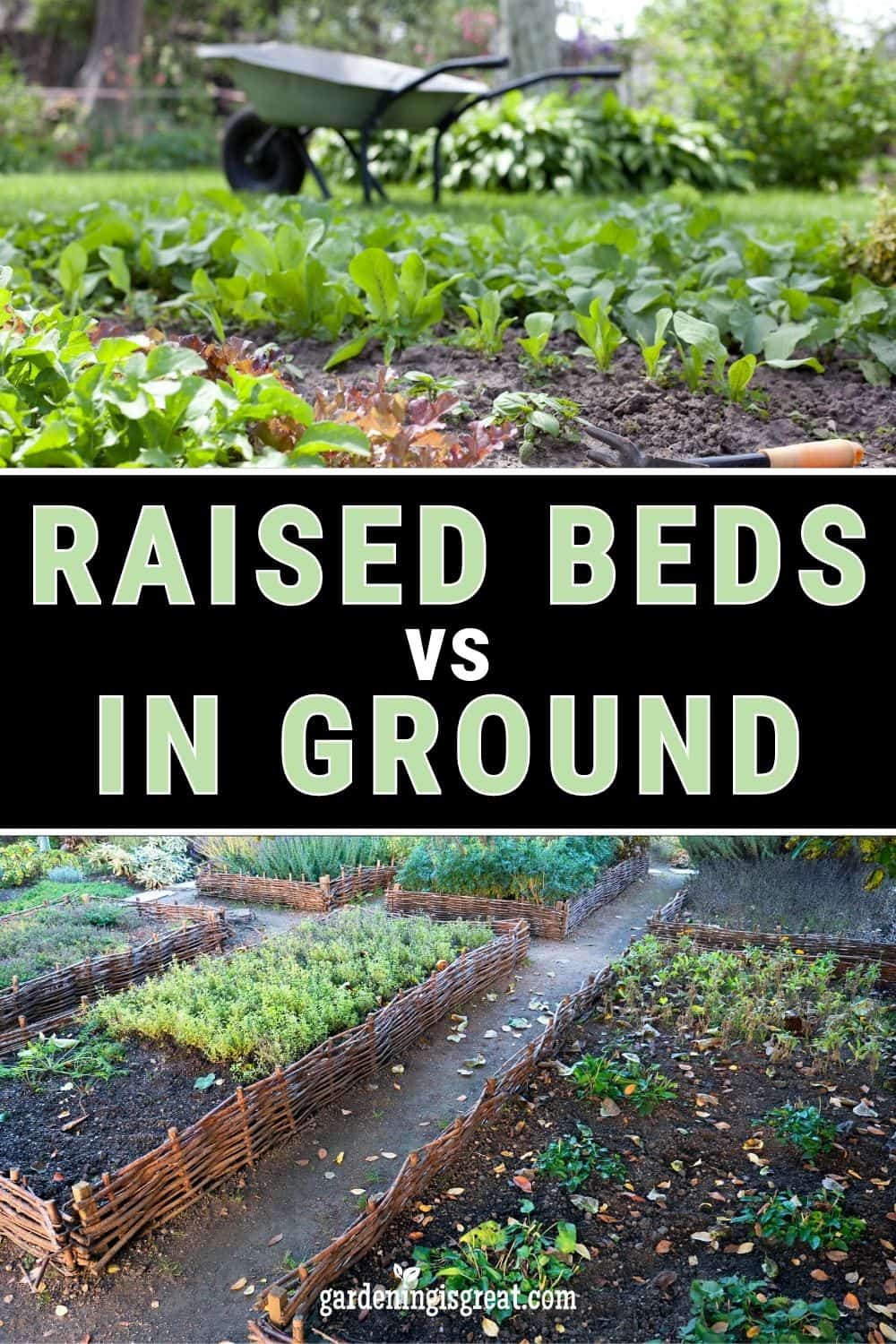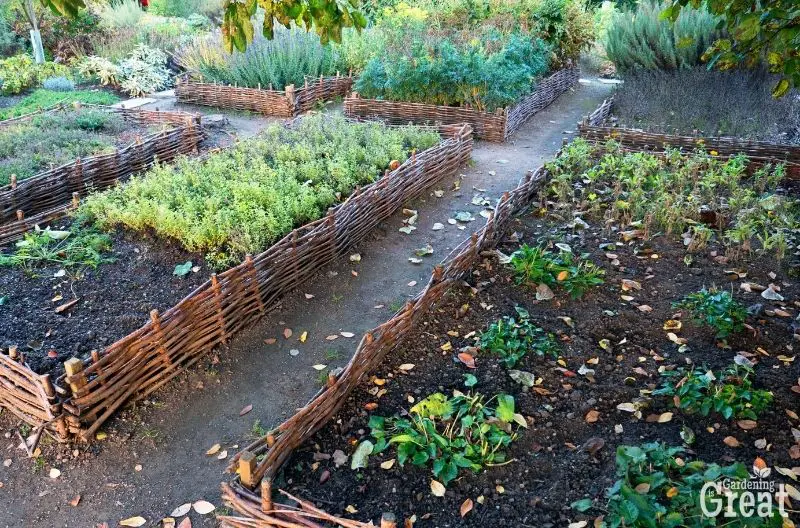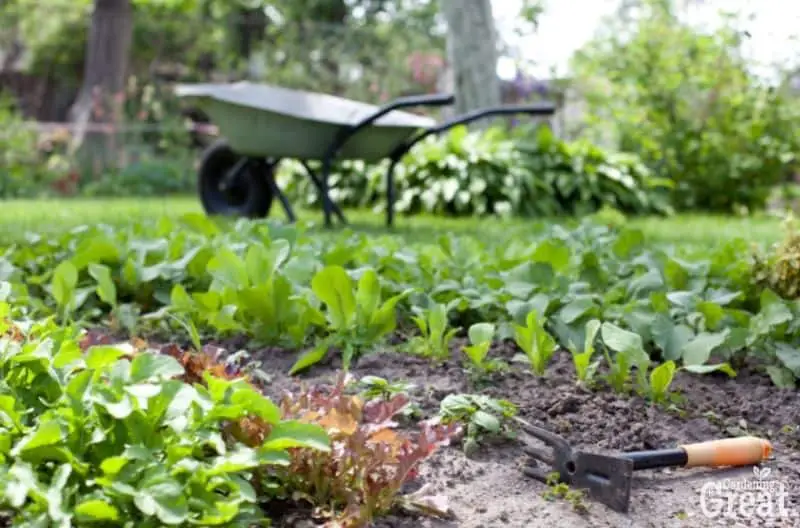Raised vs In-Ground Garden Beds: Which Should You Choose?
Garden beds are a go-to choice when it comes to landscaping your garden. But a question that often springs to mind is whether to use raised garden beds or in-ground garden beds?
Both options can look aesthetically pleasing, but what’s the right choice for you and your garden?
Garden beds are often used to help shape your outdoor space, contain plants, and add different levels to your garden.
In this post, we are going to compare both raised and in-ground garden beds. If you are looking for the pros and cons of each, keep on reading to help you choose which is the best option for your garden.

What is a Raised Garden Bed?
A raised garden bed is a bed that is higher than ground level. Quite often, they are only made to be about a foot higher than ground level and can be used for a variety of plants including fruit and vegetables.
Sometimes garden beds are built higher than this. This can be particularly beneficial if you have difficulties bending and makes your garden more accessible to you.
An easy way to picture a raised garden bed is to imagine a box with walls, soil in the middle, and no lid. This is essentially a raised garden bed that is then filled with different plants.

What do you use to make a raised garden bed?
A raised garden bed can be made with a range of materials.
The first important stage of creating a raised garden bed is to remove grass, plants, or weeds from the area where you will be placing your raised garden bed. If you don’t at a later stage, these will grow into your bed and make it very difficult to manage.
Next, you need to consider your choice of materials that will hold up your raised garden bed. Raised garden beds are commonly made with:
- Railway sleepers
- Timber
- Stone
- Brick
- Paving slabs
- Pre-cast units
- Plastic
You can choose the type of material you would like to use based on your budget, ease of cutting to size, and durability.
For example, stone is extremely durable, however, it is an expensive material and can be difficult to cut.
Whereas timber is budget-friendly, easy to cut, but even when treated doesn’t last long.
For the base, you can use a range of natural materials such as clippings, leaves, or grass and top with cardboard. The bottom layer will naturally decompose and the cardboard will prevent weeds from getting through.
Alternatively, you can use a lining made from landscaping fabric to prevent toxins from reaching the soil within your garden beds.
Once you have all of your materials, it is a case of building your raised garden bed and then filling it with nutrient-rich soil.
It is a good idea to ensure that your garden bed is not too wide or too long to prevent people from walking across instead of around them.

Advantages and Disadvantages of Raised Garden Beds
Raised garden beds are an extremely popular choice for many gardeners due to their numerous advantages over using in-ground garden beds.
Raised garden beds:
- Are easier to access. As mentioned earlier, anyone with disabilities, a bad back, or who finds it difficult reaching the ground would struggle to use in-ground garden beds. A raised garden bed enables them to still enjoy gardening but at a height that suits them.
- Improves drainage. Raising your garden beds can actually provide better drainage for your plants’ roots than if your plants were planted directly on the ground.
- Better to manage. Using raised beds makes it much easier for you to manage your garden and ensure the soil is healthy.
- Makes it difficult for garden pests. Though not impossible for garden pests to reach, using raised garden beds does make it much more of a challenge for pests to reach your plants. You can even use materials that will discourage pests from accessing your plants.
- Fewer weeds. Remember earlier how we mentioned you should remove grass, plants, and weeds from the area before you build your raised bed? Well if done properly, your raised garden beds will have fewer weeds to manage than if they were on the ground.
Now we know what’s great about building raised garden beds, you are probably questioning well why doesn’t everyone use them?
Well, that brings me to highlight the disadvantages of raised garden beds.
Like anything, there are pros and cons, and here are a few of the cons:
- They can be costly. Raised garden beds require you to purchase a range of materials and soil, not all of which are cheap.
- Quick drainage. Yes, fast water drainage can be a pro, but if it drains away too fast, particularly during the summer, then plants run the risk of not having enough water.
- Limited space. Some plants, require a large amount of soil for their roots to grow. Within a raised garden bed, they have limited space and may not thrive as well as if they were planted directly in the ground.
As you can see, there need to be some considerations made before deciding whether or not to use raised garden beds in your garden.
But before you do that, let’s take a look at in-ground garden beds as a direct comparison.
What is an in-ground garden bed?
Unlike raised garden beds, in-ground garden beds are beds created at ground level with soil already available. The beds are sometimes slightly shaped to create a gentle mound that distinguishes them from the soil around them.

How do you make an in-ground garden bed?
In-ground garden beds are much easier and cheaper to create as they don’t require a lot of tools or materials.
If you are choosing to make your very own in-ground garden bed, the first step would be to clear the area you want your bed to be from grass and weeds. Make sure you have monitored this area before beginning that it is suitable for an in-ground garden bed.
If you select an area within your garden that does not drain well and sits in water, your plants will not thrive and will likely die due to rotting roots.
Check that the area gains enough sunlight each day for your plants and has good drainage.
Next, ensure to turn over your soil with a fork so that it is loosened and offers better water drainage for your plants. At this point I also recommend mixing in compost, either homemade or from the shop that has added nutrients to help your plants thrive.
You then need to decide which plants you would like to grow in your in-ground garden beds. Consider which plants grow well together and won’t compete for sunlight, or space.
Finally, once your plants are settled, continue to maintain your garden beds to
- check the soil isn’t too damp or dry,
- remove any dead leaves or flowers,
- pull out weeds,
- and monitor and remove pests.

Advantages and Disadvantages of In-Ground Garden Beds
In-ground garden beds do appear much more cost-efficient and easier to create when compared with raised garden beds. But is that truly the case or are there any disadvantages to in-ground garden beds?
Advantages of in-ground garden beds:
- Much cheaper. In-ground garden beds require little to no materials and minimal tools that you probably already have in your garden shed. Unlike raised garden beds, in-ground beds only need a garden fork to turn the soil and mix compost, along with purchasing compost if you don’t already have some homemade.
- Easier to create. With in-ground beds, you only have to measure the space in your garden that requires grass and weeds removing and soil turning. You don’t have to measure and cut different materials to screw together in order to create a garden bed frame.
- Long-lasting. As in-ground garden beds use natural resources already in your garden, they last as long as you require them. Whereas a raised garden bed’s durability depends on the materials used to build it.
- Easy to modify. If you change your mind regarding the layout of your in-ground garden beds, you can simply dig a new area of your garden. However, with a raised garden bed they are a more permanent structure. To move them requires emptying the raised beds, bagging up the soil, potentially disassembling the materials depending on the size to move them, to then reassemble and put everything back together again.
- Unlimited design. Raised garden beds tend to be square or rectangular in shape due to the stiff materials used. However, an in-ground garden bed can be designed with more creativity due to the use of natural and flexible materials.
Overall, in-ground garden beds offer lots of advantages due to making the most of the natural resources available within your garden.
However, planting on the ground can come with a number of disadvantages too:
- Managing Pests. As your garden bed is on the ground, it is easily accessible to garden pests from slugs and snails to mice and moles. This does make it more difficult to protect your plants so ensure to have protective measures in place such as adding crushed eggshells on your soil or placing a cover over your plants.
- Weeds. In-ground garden beds are created on ground soil and so it is easy for weeds to grow and overtake your garden bed if not carefully managed. When de-weeding, make sure to pull out the weeds from their roots, otherwise they will grow back.
- Low Level. As your garden bed is at ground level, rather than at a higher level like raised garden beds, it is a lot more tiring on your body. Having to bend down can put a strain on your back and knees.
Which should you choose?
With all things considered, either option could be suitable for you and your garden. To know whether to choose raised garden beds or in-ground garden beds will depend on a few different factors.
Ensure to consider:
- How much budget do you have for your garden? If you do not have a large budget for materials, it is probably best to create an in-ground bed.
- What level can you manage your garden? If you have back difficulties or physical disabilities it might be worth building a raised garden bed so you can maintain your garden at an appropriate level to suit your needs.
- How much time do you have to dedicate to maintaining your garden? For very busy individuals, a raised garden bed is easier to maintain due to fewer pest issues, weeding, and the use of high-quality compost. Whereas if you have time to dedicate to your garden, an in-ground garden might be the better option for you.
- How often do you want to redesign/replace your garden? If you would like a longer-lasting garden bed, an in-ground garden bed would be the better choice. The materials used for a raised garden bed do not last forever and will need replacing at some point.
This post highlights the difference between raised garden beds and in-ground garden beds. With the advantages and disadvantages listed above, hopefully, it has helped you to decide what is the best option for you, your needs, and your garden.
For more tips on creating and maintaining your ideal garden, take a look at these posts below:

